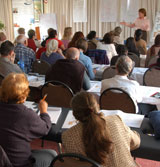Top Down and Bottom Up
Printed from http://www.bodytalksystem.com//learn/news/article.cfm?id=491 on Apr 25, 2024.
Dec 18, 2009
By Monique Fay
Growing
up I was curious to know if people down under in Australia saw the world the
same way we did. I would stand on my head to see what the world looked like
upside down.
The eyes do not "See". They collect information ...
Pareidolia is a phenomenon involving a vague or random stimulus, often an image or a sound, being perceived as significant. A common example would be to see images of animals or faces in clouds, the man in the moon. Pareidolia is an innate human tendency to impose a pattern on random or ambiguous shapes.
 standing next to one another saw the same thing. I would stand next
to my Dad when he took pictures in nature- both looking in exactly the same direction and at the same landscape. What
surprised me the most when he showed us his pictures was that none of what I
had seen was on his photographs. Where was what I had seen? In my
imagination? Or where?
standing next to one another saw the same thing. I would stand next
to my Dad when he took pictures in nature- both looking in exactly the same direction and at the same landscape. What
surprised me the most when he showed us his pictures was that none of what I
had seen was on his photographs. Where was what I had seen? In my
imagination? Or where?
Seeing is depicting the world on the canvas of our mind. The eyes represent nothing other than a medium with which our mind interprets and reconstructs our environment. Some illusions teach us to doubt and to question the many appearances of reality.
When your brain has to identify an object, it must match what you see against your stored knowledge and experiences. Taking sensory data in from the environment and analyzing relevant information is called "bottom-up processing". Bottom-up processing is tied to EMPIRICAL reality and deals with the transformation of concrete, physical features of stimuli into abstract models.
However, when your EXPECTATIONS affect perception, the phenomenon is referred as top-down or "conceptually driven processing". Top-down processing involves your past experiences, knowledge, motivations, and cultural background as well in perceiving the world. Top-down processing involves higher mental functioning that influences how you understand physical objects, signs and events.
Seeing isn't some kind of direct perception of reality.
Our brains are constantly interpreting, correcting and giving structures to the visual input from our eyes. If this were not the case, we wouldn't see any colors, and we would probably see the world upside down!
I've always been fascinated and impressed by how people with partial or total visual sensory deficiencies interact with the world. We cannot talk about visual perception or optical illusions without mentioning the other side of the coin... To understand how these people 'see' without sight is to understand just how important our sense of sight is. Sometimes we do not do sight justice or give it the importance it deserves. We fail to recognize how our sense of sight collaborates and integrates with the other sense organs. ?
Have you ever asked yourself what it is,
when we see, walk, speak, feel and touch all at the same time, that links our
sight with the sense of touch or hearing?
The reality is, we only see that on which we are concentrating
on, which is very little.
The following experiment demonstrated how,
at times, we are really 'blind' in the truest sense of the word. In this famous
experiment on 'inattentional blindness', performed in 1999, Daniel Simons and
Christopher Chabris, asked people to watch a video clip and count the number of
times one of two teams of basketball players took possession of the ball. Many
people (around 40 percent) didn't notice at all a man in a gorilla suit
entering stage right, doing a jig in the centre of the screen and then leaving,
stage left. The clip demonstrated how we don't see what we don't pay attention
to, even when it's in front of our eyes!
Man, without the support of the other
sense organs would truly be lost, because it is the other senses which permit us, subconsciously, to go about
our everyday lives.
What the images in The Book of Fay can do for us is to open all of our senses and start to break down our restrictive and limited patterns, and experience ourselves, and the world around us, more fully and let us have some fun in the process too.








